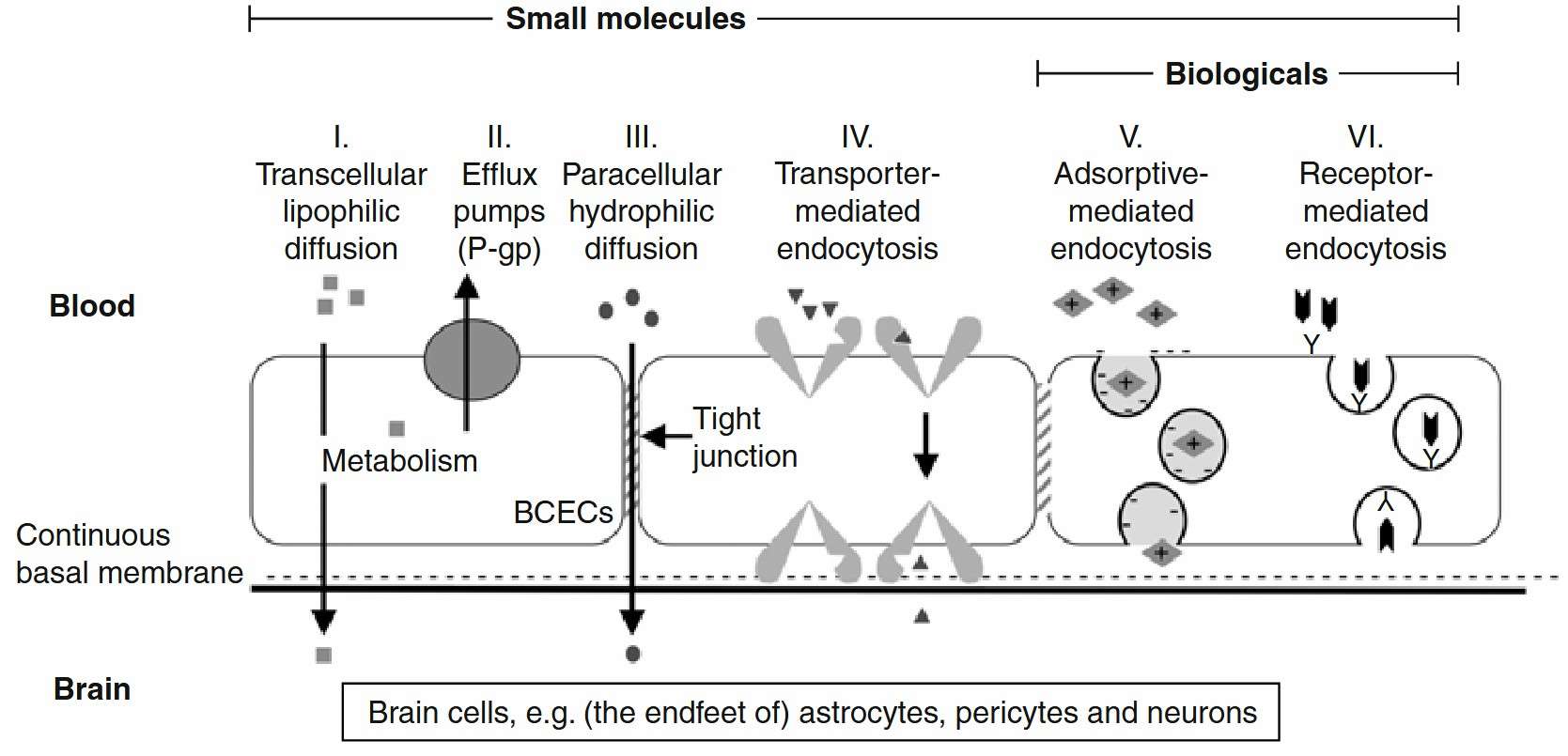How to Improve Drug Distribution in the Brain
The blood-brain barrier (BBB) is a significant barrier to drugs entering the brain, and has been a conundrum for decades for scientists who are seeking to diagnose central nervous system (CNS) diseases and other brain disorders. This physiology has imposed a backlog on the development of effective treatments for brain conditions, some of the most common and difficult-to-treat worldwide. As the ageing population and CNS diseases rise, the need for new forms of drug delivery that can trump the restrictions of the BBB is clear. Researchers are now working on chemical and biological delivery strategies, altering the permeability of the BBB, and designing novel drug carriers, such as nanoparticles and molecular Trojan horses, to enable drugs to be better transported through the BBB. This article provides a summary and review of some CNS drug delivery improvement strategies.
 Fig. 1. The various transport processes that may occur at the blood-brain barrier (de Boer AG, and Gaillard PJ, 2007).
Fig. 1. The various transport processes that may occur at the blood-brain barrier (de Boer AG, and Gaillard PJ, 2007).
Optimizing Drug Delivery Methods
Intracerebral administration
The primary methods are transcranial delivery and intrathecal injection. Transcranial techniques include ventricular infusion, convection-enhanced delivery (CED), and implants. Small lipophilic molecules are rapidly removed from the CSF to systemic circulation, while hydrophilic macromolecules have a low clearance rate. Thus, intrathecal injection is often utilized to bypass the BBB for proteins and peptides.
Bypassing BBB delivery
This mainly involves nasal and intralabyrinthine delivery. Drugs enter the CNS via the nasal route through pathways such as the olfactory bulb, trigeminal nerve, vascular system, CSF, and lymphatic system. Some researchers believe that the perilymph fluid of the inner ear connects with CSF via the cochlear aqueduct, allowing brain-targeted delivery through the inner ear. The main advantage is its minimally invasive nature; however, the limitations are low transport dose and efficiency.
Selective Disruption of the BBB
Agents like mannitol (20%-25% administered via carotid artery infusion), focused ultrasound, photodynamic therapy (PDT), electromagnetic fields, and other chemical substances are used to selectively disrupt the BBB, enhancing drug permeability. But this strategy could allow poisons to percolate into the brain.
Inhibition of the Blood-Brain Barrier Efflux System
Efflux carriers in the BBB include breast cancer resistance protein (BCRP), P-glycoprotein (P-gp) and multidrug resistance-associated proteins (MRPs). These transporters work together to prevent certain drugs from entering brain tissue. The use of endogenous or exogenous antagonists, like endothelin-1 (ET-1) and pluronic block copolymers, can increase intra-brain drug concentration.
Enhancing the BBB Permeability of Candidate Molecules
Mimicking endogenous molecules
By designing drugs with templates from endogenous molecules, including free neuropeptides, the drug will have specific interaction with transport proteins to pass through the BBB. But transport proteins are limited by the size and shape of the ligand, restricting their transport to small molecules with a defined substrate. Additionally, competition between endogenous-like molecules and transport proteins can interfere with neurotrophic transport and alter CNS homeostasis.
Drug structure optimization
Chemo modification molecules are permanently bonded to target molecules during the development of prodrugs. Amino, hydroxyl or carboxyl compounds are esterified or amidated into lipophilic prodrugs. When taken, these modifications are excreted enzymatically or hydrolytically to release the active compound. This makes it more lipophilic and more apt to bind to transport proteins, reducing BBB permeability.
Lipid modification
Lipophilicity is critical to the passive delivery of drugs across the BBB. Hyalogenation, cyclization and methylation can increase the lipophilicity of peptide molecules and increase BBB penetration. Lipid-modified drugs can become efflux pump substrates, which would have to be merged with efflux pump inhibitors for clinical use.
| Influential Factors | Property Characteristics |
| Molecular Weight | Should be within 400-600. |
| Hydrogen Bonds | Fewer hydrogen bonds increase lipophilicity. |
| Polar Surface Area (PSA) | Effective BBB permeation requires a PSA of 60 to 90 Å2. |
| pH | An optimal range of 7-8, preferably positively charged, with a pKa of 7.5 to 10.5. |
| Solubility | Drug solubility should exceed 60 mg·L-1 |
Glycosylation modification
Glycosylation modifies protein molecular conformation, affecting its function and enhancing stability. They are also boost the BBB permeability of peptides and monoclonal antibodies (mAbs).
Drug Carrier Conjugation
Monoclonal antibody drug delivery
Monoclonal antibodies (mAbs) are largely homogenous antibodies produced from a single parent cell line, with very distinct affinity for antigen epitopes. Drug delivery using mAbs is designed to produce mAbs that specifically target receptors on the BBB surface, allowing receptor-mediated endocytosis of drug candidates into the brain. Potential receptor targets include insulin receptor (IR), transferrin receptor (TfR), low-density lipoprotein receptor (LDLR), low-density lipoprotein receptor-related proteins 1 and 2 (LRP1 and LRP2), and diphtheria toxin receptor (DTR).
Cell-penetrating peptide drug delivery
The cell-penetrating peptides (CPPs) are short peptides (often fewer than 30 amino acids) that cross the cell membrane with amphipathicity and net positive charge. CPPs deliver many bioactive molecules, such as proteins, peptides and nucleic acids, efficiently into cells.
| Products & Services | Description |
| Quantitative Tissue Distribution | Creative Bioarray provides quantitative tissue distribution services to help our customers visualize true tissue distribution, facilitate tissue PK analysis and dosimetry prediction before the initiation of human mass balance studies. |
| In Vivo Blood-Brain-Barrier Assay | Creative Bioarray has established a simple, reliable and efficient in vivo assay that has been successfully applied to several genetic and experimental mouse models. |
| Brain Tissue Binding Assay | Creative Bioarray provides Brain Tissue Binding Assay to help customers accurately detect the drug transport and distribution in the brain. |
References
- Azad TD, Pan J, et al. Therapeutic strategies to improve drug delivery across the blood-brain barrier. Neurosurg Focus. 2015. 38(3):E9.
- de Boer AG, Gaillard PJ. Strategies to improve drug delivery across the blood-brain barrier. Clin Pharmacokinet. 2007. 46(7):553-76.

